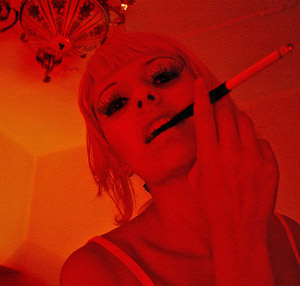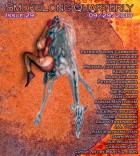The actual painting of “Boy with Cherries” models a young man named Alexandre, who was Manet’s assistant. The boy committed suicide at age 15 in Manet’s studio. I read this story many times before inquiring into the meaning behind the painting, but once I discovered it, the story shifted in an almost sinister way. What are you hoping readers take away from the painting and the story it inspired?
Let me offer some context: “Boy with Cherries” is one of about 65 little stories (I call them “plates”) that make up the book Color Plates. While writing the Plates, I kept in mind an approach the poet John Taggart described to me in a lettter: rather than write about an artwork, write from it.
Each plate begins with the painting, for sure, but readers don’t need to see the painting, or to know anything about the artist’s life, to appreciate the story. Sure, I’ve read about Manet, but I’ve only studied the paintings (and in most cases, prints; I’d love one day to see all the paintings in person). The famous paintings, such as “Luncheon on the Grass” or “Olympia” were hard to write from, because stories about them were already established; it was easier to write from a painting about which I knew nothing. “Boy with Cherries” was like that. I didn’t know the model committed suicide until after I’d written the story. (One of Manet’s beloved models—Victorine—did, however, become a character in Color Plates—when I knew the histories, I used them.)
That the story “shifted in an almost sinister way” once you’d read about the painting’s history is wonderful. For what it’s worth, I think there’s something foreboding about the story. (It is, by the way, the first story (after the prologue) in the book, and the first of several to include the characters Brother and Sister—it sets up quite a lot.)
The simplest answer to your question is that the story is in the world now; readers will bring themselves to the story, and make of it what they will. And that’s good
I’m curious to see how the Brother and Sister story progresses. I will have to look forward to your book. Tell us more about it, including when it will be released.
I didn’t know what Color Plates would be when I began—not an unusual situation for a writer, as I’m sure you know. You start, and you pay close attention. At some point, you see the piece for what it might be. An early cue for me was Brother and Sister. (“Boy with Cherries” is their first appearance in the book, but not the first plate I wrote for/with them; that was “Cirque Fernando”). Once that first Brother and Sister story was written, I had a much better view of the book.
That said, there are only about eight Brother and Sister plates out of 67. Color Plates isn’t their story—their story is contained by Color Plates. If any one figure is central to the book, it’s a mythical Mary Cassatt, whose mind houses the weird collection that the book is.
Smokelong accepted “Boy with Cherries” as we (me and Rose Metal Press) were finalizing the book’s design; it’ll be released mid-September, with two Chicago readings to celebrate (and begin a still-developing book tour).
In addition to the “sinister” or “foreboding” atmosphere, this story also feels otherworldly to me. There is a crumbled stone wall, a midget or a boy with a bellhop hat selling cherries, and an odd dream-like sequence half-way through the piece. If you were to describe this story in a word or two, which words would you use?
Weird realism.
Childhood, Kelly, is weird.
Indeed it is! On that note, what’s the weirdest childhood memory you have?
You want me to give up my prime material? No, no, I need that stuff secreted away for use (and frequent re-use) in my writing. Well. Okay. I don’t like to disappoint. This isn’t the absolute weirdest memory. It’s a little strange, I guess. It’s mysterious. Probably not that mysterious. Probably someone reading this will say, “That’s not mysterious at all.” Here it is.
In early November, which is by far the eeriest time of the year—at least in New England—I was in the woods near my house—a strictly forbidden locale. I was, uh, seven? I was pretty deep in the woods and I took a path I hadn’t taken before. It was probably about three in the afternoon—the sun already a little low in the sky. From somewhere off the path I heard a grunt. This scared the living daylights out of me, I was sure it was a wild boar—not likely, but, you know, I was seven. I didn’t want to run away. I knew from experience that dogs tended to chase me when I ran, so I kind of backed up for a while, took every step painfully slow. Somehow, I managed to walk a loop, and ended up off the path at the mouth of a huge pit. I kid you not. I peered over the edge. The low light lit just a crescent of the bottom of the pit. It was, I thought (remember I was seven, so who knows), about fifteen feet deep. And I heard another grunt. Oh God it was so loud, Kelly! I saw a big animal, uh, kind of bumble through that crescent of light and I ran. I crashed thru brush and branches, until I found my way to the path and finally to my little neighborhood. By the time I got home I was wheezing pretty hard and it took my worried mother a little while to get the story from me. She was mad, of course, that I’d been in the woods, but not madder than she was a) glad I was home and b) troubled that there was a large animal in a pit in the woods behind her house.
I hope this isn’t a let down but there really isn’t much else to the story. I guess Mom called the police or animal control or something. I eventually found the path again—foolish curiosity. It was full-on winter by then and the ground was covered with snow. A little distance off the path I found a frozen pool. I poked a branch through the ice. It wasn’t deep, a few inches, all that remained of a vernal pond, probably. I don’t know if that was the spot. I told my buddy Brian about it and we believed fervently that there was a beast tunneling in the woods behind my house and then we got to junior high and didn’t believe anymore (and didn’t hang out anymore, either).
Is that weird? I don’t know. I’m sure there are weirder childhood tales. Anyway weirder things happened to me.
What’s next on your writing “to-do” list?
I’m trying to put together a little collection of strange stories to send to a press that has expressed interest in such a thing. I hear the publisher has gobs of money he wants to give to me. Or maybe not. With only a few days before September, when I promised myself I’d write a new Bolivia story for Danel Olson’s next anthology, I’m writing furiously, whenever my daughter is asleep or otherwise not in need of tickling and cups of milk. I’m working on my translation of Sir Gawain and the Green Knight, the first fitt (not a typo) of which can be found in the August issue of Open Letters Monthly . I also hope to finish a couple poetry projects by the end of the year, including a long poem dedicated to Jessica Smith called “Outland.” There’s a novel, too, which is slow-going because I seem only able to work on it in longhand, on loose leaf paper, with pencils, and I can’t run the electric sharpener after 7 p.m. for fear of waking my aforementioned daughter. What I’ve written is gorgeous, though.



 The core workshop of SmokeLong Fitness is all in writing, so you can take part from anywhere at anytime. We are excited about creating a supportive, consistent and structured environment for flash writers to work on their craft in a community. We are thrilled and proud to say that our workshop participants have won, placed, or been listed in every major flash competition. Community works.
The core workshop of SmokeLong Fitness is all in writing, so you can take part from anywhere at anytime. We are excited about creating a supportive, consistent and structured environment for flash writers to work on their craft in a community. We are thrilled and proud to say that our workshop participants have won, placed, or been listed in every major flash competition. Community works.